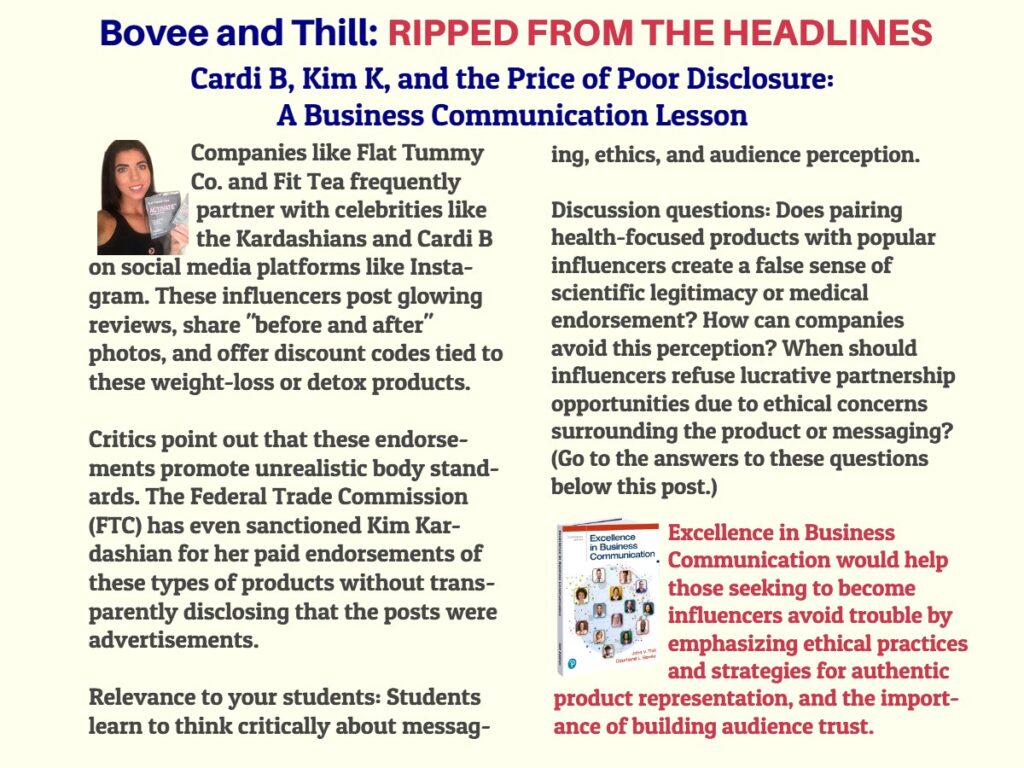 ANSWERS:
ANSWERS:
Here's a breakdown of the questions and how to approach answers, considering some ethical complexities involved:
Question 1: Does pairing health-focused products with popular influencers create a false sense of scientific legitimacy or medical endorsement?
Yes, it often can. Many influencers don't have qualifications in health, nutrition, or medicine. Their popularity arises from other factors (aesthetics, entertainment value, etc.). When they promote health products, it can mislead audiences into thinking there's more scientific backing than there is.
The "Halo Effect": We trust people we like or find attractive. Their presence alongside a product makes us favorably disposed towards it, even without solid evidence.
Companies intentionally do this: They know influencers will boost sales even if the influencer lacks genuine expertise.
Question 2: How can companies avoid this perception?
Transparency: Clear disclaimers that an influencer is not a medical professional, and their statements shouldn't replace advice from a doctor.
Vetting: Work with influencers who align with evidence-based health practices. Someone selling detox teas is probably not a great choice if a company truly cares about the science behind their products
Tone Down Claims: Instead of making big promises, focus on how a product might fit into a balanced lifestyle. Avoid sounding like the influencer is prescribing medication.
Question 3: When should influencers refuse lucrative partnership opportunities due to ethical concerns surrounding the product or messaging?
This is a personal line each influencer must draw, but here are situations where refusal is likely warranted:
Conflicts of Interest: If the product goes against the influencer's normally stated beliefs (e.g., a vegan influencer promoting a meat-heavy diet for money).
Dishonesty: When the influencer knows the claims about the product are deceptive or exaggerated.
Potential Harm: If there are known risks associated with the product, especially if the influencer's followers are a particularly vulnerable demographic.
Gut Feeling: If something makes them genuinely uncomfortable, even if they can't pinpoint the exact reason, sometimes listening to one's internal ethical compass is necessary.
Additional Thoughts
Regulation is lacking in this space, allowing dubious practices to continue. Consumers and influencers themselves need to be aware of these marketing tactics.
Critical thinking is needed by consumers. Don't trust health claims from someone just because they're famous or look fit.
Fame doesn't equal knowledge. A huge following does not equal medical expertise.
By dissecting real-world situations like these, and as in done in Excellence in Business Communication, 14th Edition, business communication students learn to think critically about messaging, ethics, and audience perception. They recognize the power of persuasive techniques and identify instances where those techniques cross into manipulation. Analyzing "ripped from the headlines" scenarios demonstrates the real risks when communication goes wrong, preparing students to become thoughtful and responsible communication professionals.
————————————————————————————————————————————————————————-
Subject: Spark Student Interest in Business Communication with "Ripped from the Headlines" Discussions
Dear Business Communication Instructor,
Want to prove your subject matter isn't just theory? This newsletter links your lessons to THIS WEEK'S news – crisis communication fails, deepfakes, AI blunders, and more. It's packed with ready-to-use talking points to show students how their business communication skills will be essential in their future careers.
This headline supercharges student motivation with these key strategies:
Extrinsic Motivation: It directly links course material to potential career consequences, acting as an extrinsic motivator. Students understand that business communication isn't just about grades, but about real-world success.
Intrinsic Motivation: Analyzing current events and engaging in lively discussions fosters intrinsic motivation. This makes learning enjoyable and builds a positive association with the subject matter.
Relevance-Based Motivation: Demonstrating how current headlines relate to core concepts enhances motivation. Students see the subject as important and timely, boosting interest and engagement.
Need to streamline your lesson planning? This newsletter does the prep work for you! Each story links to a key business communication concept and includes thought-provoking discussion questions. We hope this makes your classes the ones students can't stop talking about!
This dynamic teaching is made possible with Excellence in Business Communication, a textbook that stands out with its unmatched focus on real-world skills and the rapidly evolving digital landscape. It features current headlines, explores the complexities of AI and deepfakes, and prioritizes ethical, adaptable communication in a way no other textbook does.
This contemporary approach means students won't just learn theories–they'll tackle the problems facing today's businesses. Emphasis on critical thinking and audience analysis prepares them to adapt to communication challenges on the horizon. With "Excellence," lessons transcend the classroom, ensuring graduates enter the workforce with a competitive edge.
The emphasis on building trust and authenticity in this era of heightened skepticism reinforces the value of true connection alongside technological efficiency. This is why Excellence in Business Communication is being so widely adopted by business communication instructors in 2024.
See the brochure for Excellence in Business Communication, 14th Edition: Video: . How Does Your Text Compare? . To request examination copies of Bovee and Thill's award-winning business communication textbooks (instructors only), visit this ordering page.



